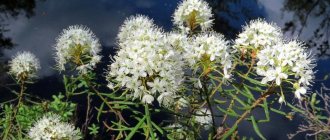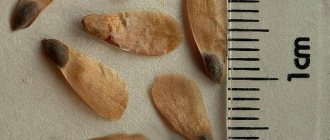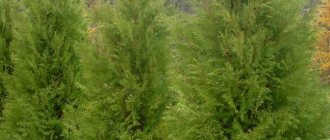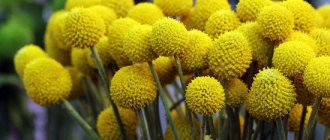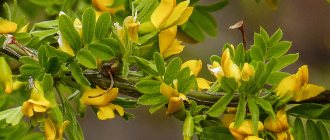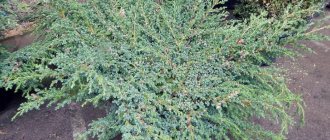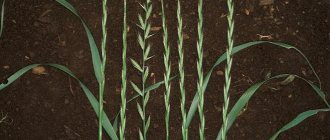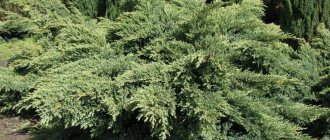In this article we will take a closer look at what a plant called ledum palustre is. The reader will be able to find out in more detail what medicinal properties this plant has, as well as what contraindications and warnings exist in using wild rosemary as a medicine. We will note such points as the intricacies of production and procurement of raw materials, as well as the preparation of some medicines, where the main ingredient is the wild wild rosemary plant. We will also take a closer look at how to use this remedy correctly.
Botanical and morphological description
Ledum is a plant from the heather family, which is an evergreen shrub or shrub with a height ranging from 20-125 centimeters. It has oblong and narrow leaves with edges curled to the underside. From the bottom they have a reddish pubescence, reminiscent of felt in a tactile sense. The flowers of the plant are white, mounted on thin stalks. They grow up to a centimeter in diameter, but they are located quite densely. The standard form of wild rosemary inflorescence is a shield or an umbrella-shaped raceme, it all depends on the subspecies of the plant.
Instead of flowers appearing in May or June, fruits are formed by August. Ledum fruits are elliptical capsules with a length of three to eight millimeters. As it ripens, it opens and releases seeds. They are light yellow, flat and spindle-shaped. The length of the seeds does not exceed one and a half centimeters.
Important: Since the plant spreads along the borders of swamps or even in their area, it has powerful roots that penetrate at least 25-40 centimeters deep.
Collection, preparation, drying
Best materials of the month
- Coronaviruses: SARS-CoV-2 (COVID-19)
- Antibiotics for the prevention and treatment of COVID-19: how effective are they?
- The most common "office" diseases
- Does vodka kill coronavirus?
- How to stay alive on our roads?
For medicinal purposes, only non-lignified, young leafy (current year) shoots not exceeding 10 cm in length are harvested. The period for collecting raw materials occurs in August-September, when the plant bears fruit. Harvesting lignified 2- or 3-year-old shoots is unacceptable. Interestingly, the grass has a low regenerative capacity, so after cutting the stems, the biomass is restored within 3 years. Because of this, it is possible to harvest shoots from one place no earlier than after 8 years. After collection, the plant is dried in the shade under a canopy or in specialized dryers. In the first case, the grass is scattered in a layer 10 cm thick and left in the fresh air in dry weather with normal air humidity (up to 75% in the warm season). As is correct, the drying time in this case reaches 14 days. In the second option, the raw materials are placed in an apparatus that maintains the heating temperature in the range of 35-45 degrees. The grass is left until completely dry.
The shelf life of harvested raw materials does not exceed 3 years.
Remember, wild rosemary is a poisonous plant; in order to avoid poisoning the body and getting an allergic reaction when working with the grass, you should follow safety precautions: wear gloves and a respirator.
Common subspecies of wild rosemary
- Swamp wild rosemary has the most pronounced medicinal properties. But this cold-resistant shrub is dangerous outside of industrial pharmaceuticals, since it contains many toxic components. This subspecies of wild rosemary is the most widespread throughout the world, therefore it is often found in gardens along with other heathers;
- Creeping wild rosemary grows in Siberia, the Russian part of the Far East and in North America, in Greenland. Its height does not exceed 20-30 centimeters, which makes the plant the shortest among other subspecies. It is famous for the largest flowers among wild rosemaries. The buds reach two centimeters in diameter;
- Greenland wild rosemary is found everywhere in the Arctic zone. It prefers peat bogs and wet banks of rivers or lakes. Greenland wild rosemary can be distinguished by its larger size. This plant reaches two meters in height;
- Ledum "Kompakta" is an artificially cultivated shrub based on Greenland shrub, used for decorative purposes. Its height does not exceed 45 centimeters. And the demand among gardeners is due to the unusual cream color of the semicircular inflorescences;
- Large-leaved wild rosemary grows in the eastern part of Eurasia. It prefers the undergrowth of mountain coniferous forests, and is less common in sphagnum bogs and along the perimeter of stone placers, among heather. The maximum height of such a plant is 130 centimeters. And it blooms in the second ten days of May.
Types of wild rosemary
The genus Ledum has only 6 species of plants. Of these, 4 grow in Russia.
Marsh rosemary. A typical representative of the genus, distributed in temperate climates. It is a dense bush up to 1.2 m high. Raised branched shoots are covered with rusty short pile. The dark green shiny leaves exude a pleasant scent. At the end of spring, dense umbrellas or shields with white or light pink small flowers bloom.
Marsh rosemary
Greenland rosemary. Rigid lodging stems grow up to 90 cm in length. They are light brown in color. On the shoots, narrow linear leaves are located close to each other, like bright green soft needles. There is felt pile on the reverse side of the rolled leaves. During the flowering period, small (up to 6 cm wide) umbrellas with white or cream flowers bloom. The species tolerates even severe frosts excellently.
Greenland rosemary
Large-leaved wild rosemary. An inhabitant of the Far East, Japan and Korea, it grows 40-80 cm in height. It settles on rocky embankments and mountain slopes. The oval foliage is 3-4 cm long and 8-15 mm wide. There is thick red hair on the young shoots and the back of the leaves.
Large-leaved wild rosemary
A few years ago, rhododendron was synonymous with wild rosemary. Until now, some flower growers attribute the Transbaikal wild rosemary to this genus, but in fact it is only a distant relative and has the scientific name “Daurian rhododendron.” The plant is also a highly branched bush 50-200 cm in height. The branches are covered with narrow, dense leaves of a dark green color. But the flowers have a rich pink tint. Often this “ledum” can be seen in a vase in a bouquet arrangement.
Wild rosemary
Superstitions about swamp bush
Most beliefs say that wild rosemary, hung around the house, is able to ward off evil spirits. It is also believed that it can be used to prepare a powerful love spell. But, at the same time, wild rosemary is considered a component of potions of dark sorcerers: according to village superstitions, potions made with its juice break love and friendships, send madness or sharpen libido. By the way, people have quite objective reasons to see wild rosemary as potential evil. Its aroma provokes migraines or even severe poisoning, especially during flowering.
Chemical composition of wild rosemary
The herb wild rosemary contains essential oils, including palustrol, ledol, cymene, geranyl acetate and other complex substances. They provide the plant with a characteristic pungent odor. It also contains the flavonoid quercitrin, the glycoside arbutin, numerous phytoncides, organic acids and vitamins beneficial to humans. The plant contains resins and tannins in lower concentrations. It has been noticed that the older the plant, the more dangerous components there are in its chemical composition. Therefore, only relatively tender one-year-old shoots are suitable for harvesting.
Important: The valuable essential oil of wild rosemary occupies approximately 3% of the total mass of the above-ground part of this medicinal plant, which is considered a good indicator.
Beneficial features
The leaves and flowers of wild rosemary contain many biologically active substances, recognized not only by folk medicine, but also by official medicine. Among them:
- essential oils;
- tannins;
- flavonoids;
- ascorbic acid;
- gum;
- phytoncides.
Since ancient times, the decoction has been used as an antiseptic and antibacterial agent. It was used externally, added to baths or compresses, and also drunk to combat coughs, ARVI and intestinal infections.
Tea with the addition of wild rosemary leaves soothes and fights insomnia. The plant copes well with diseases such as pneumonia, whooping cough, bronchitis, liver and kidney diseases, gastritis, eczema, boils, chickenpox, cholecystitis. The drugs are also useful for women's health. They strengthen muscles and fight sexually transmitted diseases. Moreover, in different countries the “specialization” of wild rosemary may differ.
They have plants and economic purposes. The smell of leaves repels blood-sucking insects and moths.
Ledum is contraindicated for people who suffer from allergies and are sensitive to the components of the plant. Since it increases the tone of the uterus, treatment is unacceptable for pregnant women. And of course, the dosage cannot be exceeded, so treatment is best carried out under the supervision of a doctor.
Areas of application of the plant
Ledum is widely used in completely different branches of human activity. It is used to create oil for leather processing, soap making, textile industry, and perfumery. In all these areas, oil acts as a fixative. The fresh leaves of the plant help protect clothes from moths and other pests. And in the last century and earlier, wild rosemary was used in counterfeit brewing. But such a drink provoked delirium, hallucinations, abdominal pain and severe colic, so this brewing technology was abandoned.
Also, all varieties of this plant help treat farm animals and are good honey plants. But wild rosemary honey is dangerous for humans, so it can only be eaten after boiling, or better yet, left to bees for the development of families. In addition, not a single area of application of wild rosemary can be compared in scale to medicine.
Medicinal properties
- Softens cough during colds and infectious diseases;
- Relieves itching after mosquito bites;
- Improves sputum production;
- Suppresses allergic reactions caused by non-plant pathogens;
- Promotes the release of sweat and maintains the balance of salts in the body;
- Relaxes the smooth muscle tissue of the bronchi;
- Eliminates inflammation;
- Dilates blood vessels and normalizes blood flow;
- Relieves pain in respiratory diseases;
- Has a bactericidal effect;
- Accelerates metabolic processes, including having a diuretic effect;
- Restores hair and strengthens nails.
Indications for use in medicine
- Dysentery;
- Diabetes;
- Angina;
- Pneumonia;
- Whooping cough;
- Rickets;
- Enterocolitis;
- Acute or chronic forms of bronchitis;
- Laryngitis;
- Pulmonary tuberculosis;
- Furunculosis;
- Scabies;
- Chicken pox;
- Flu;
- Polyarthritis;
- Arthrosis of deforming type;
- Scrofula;
- Acute or chronic rhinitis;
- Rheumatism, gout and other joint diseases;
- Neurodermatitis;
- Eczema;
- Insect and arthropod bites;
- Lichens of bacterial and non-bacterial origin;
- Wounds, bruises, bruises, scratches and other skin damage.
Scientific research about wild rosemary
The very first information about wild rosemary appears in Danish manuscripts of the 12th century. It is also found in ancient Scandinavian herbaria. In medical practice, it was first recorded in Sweden. And the first studies of the healing characteristics of the plant belong to Carl Linnaeus. But wild rosemary found its greatest fame in Russia in the 19th-20th centuries.
In 1896, Russian scientist Karl Andreevich Rauchfuss first isolated essential oil from fresh wild rosemary. He described it in one of his scientific works and pointed out that essential oil consists of crystalline particles and liquid. And in 1912, academician Andrei Petrovich Krylov first described the rules for treating whooping cough using medicines based on wild rosemary. Several decades later, the first information appeared that wild rosemary is suitable for the treatment of bronchial asthma, acute bronchitis and cough. The plant was actively used during the Second World War.
Important: Research on wild rosemary continues in the 21st century; for example, at Tomsk Medical University it was proven that the plant inhibits free radical processes in the body.
Description of the wild rosemary plant
A representative of the Heather family grows from 50 to 120 cm, has an extensive root system that goes deep into moist, swampy soil. Its leaves are quite narrow and remain green all year round. Flowering begins with the arrival of spring and ends at the end of June. Pink or white inflorescences are collected in umbrellas and reach 1.5 cm in diameter. The fruits are a capsule with small seeds.
Ledum
Where does wild rosemary grow in Russia?
The cold-resistant plant is found in tundra and forest zones, swampy areas of coniferous forests, and peat bogs. It prefers acidic, poor, highly moist soils. Where exactly does wild rosemary grow in Russia? In the Far East, Western and Eastern Siberia, the north of the European part, Eastern Altai, and the foothills of the Sayan Mountains.
Contraindications
Data on whether it makes sense to use wild rosemary in treating children varies. Some sources say that medications based on this plant can be given from the age of 14, while others claim that wild rosemary is dangerous until the age of 18. Therefore, before using the medication, you should consult your pediatrician. Among the strict prohibitions are glomerulonephritis, hypotension and hepatitis. It is also prohibited to give medications containing wild rosemary if the patient is diagnosed with individual intolerance to its chemical composition.
Important: It is not recommended to use medicines on wild rosemary if a person has suffered a serious illness or surgery - the poisonous components can have a bad effect on his health.
Properties of culture
Burnet herb: description, beneficial properties, application
Swamp wild rosemary has quite varied properties. Widely used in both traditional and folk medicine, homeopathy and pharmacognosy.
The medicinal properties of the wild rosemary herb depend on the amount of essential oil it contains. The higher the percentage of content, the greater the therapeutic effect.
Medicinal properties of wild rosemary
Indications for the use of decoctions and infusions from this herb are quite extensive. It is successfully used as an expectorant, diuretic, anti-inflammatory, and antiallergic agent. Before starting treatment with this plant, it is necessary to study the characteristics of the culture. Uncontrolled use can cause serious harm to the body.
Attention! Ledum is considered a poisonous herb, so it has contraindications. Before using medications that contain herbs, you should read the instructions or consult a doctor.
Ledum preparations and methods of their use
There are many recipes online that involve creating wild rosemary preparations at home. But doctors oppose such measures. The fact is that incorrectly collected or prepared raw materials and even the slightest imbalance in the proportions of the components can only worsen the patient’s condition. Therefore, it is better to choose one official medicine.
Ledin
Ledin is a name given to tablets whose effect is due to sesquiterpene alcohol. And it, in turn, is extracted from the essential oils of marsh wild rosemary. Ledin is prescribed for the treatment of dry cough, and in parallel with it, expectorants must be taken to speed up the action. The drug is taken orally at 0.05-0.1 grams three to five times a day, regardless of the diet. The course must be continued until relief occurs, but it cannot last longer than 10 days. The cost of Ledina is no less than 1277 rubles. And it’s almost impossible to buy it: it is no longer registered in Russia.
Ledum-GF
The homeopathic drug Ledum-GF is an ointment for external use. It is prescribed for joint pain, as well as for swelling or itching caused by insect or arthropod bites. The ointment is applied in an even layer to the affected area up to four times a day. However, it is prohibited to put a bandage on it. Doctors have different attitudes towards this remedy. Firstly, not everyone trusts homeopathy. Secondly, it often provokes allergies. And a jar of Ledum-GF ointment is quite expensive - about 288 rubles for 25 grams of product.
Fitopril
Fitopril normalizes the heartbeat and corrects blood pressure. It is suitable for the treatment of cardiac arrhythmias, as well as for the prevention of myocardial infarction and stroke. The effect is due to the action of natural beta blockers, which reduce the number of heartbeats per minute. The whole product consists of plant components, among which are wild rosemary herbs. The dosage regimen is quite simple: drink one tablespoon of liquid per day. Fitopril will cost no less than 690 rubles per bottle.
Marsh wild rosemary shoots for brewing
You can also buy simple shoots of wild rosemary at the pharmacy. This dry herbal raw material is prescribed for acute and chronic lung diseases accompanied by cough. The therapeutic effect is due to essential oils that provoke expectoration and relieve spasm from the smooth tissues of the bronchi. The shoots should be brewed at the rate of 10 milligrams per 200 milliliters of water and taken orally half a glass twice a day. The market price for this natural herbal remedy is 59-80 Russian rubles.
And the name suited him
Ledum in Siberia are deciduous rhododendrons that bloom profusely in early spring. This is wrong, but it is so generally accepted that I, without further ado, will begin to call them that. Moreover, real wild rosemaries (Ledum) and rhododendrons (Rhododendron) are so close that not all botanists recognize them as separate genera. Indeed, wild rosemaries and rhododendrons have a lot in common. How they differ, other than the size of the flowers, I personally don’t know. They are all shrubs. With the onset of frost, the leaves that have not fallen for the winter are rolled up into tubes. The flowers of real wild rosemary, although small, have a structure typical of all rhododendrons: a corolla of five petals and long, far-protruding stamens, characteristic of both of these shrubs. And even if we touch on their agricultural technology, then they have similar preferences. As for the Siberian rhododendrons called wild rosemaries (and there are 4-5 species), their differences are even more blurred. If you don’t look too closely at the details, then from a distance they practically look alike. And their flowers, with the exception of the Schlippenbach rhododendron, are difficult to distinguish even up close. Dahurian rhododendron (R. dahuricum) - due to its prevalence, this species most often falls under the name wild rosemary. Its discontinuous range extends from Altai to Sikhote-Alin. Deciduous shrub with a usual height of 70-120cm (rarely up to 2m). The leaves are elliptical, up to 6 cm long, up to 2 cm wide, on short petioles. In autumn, most of the leaves turn yellow and fall off, but a few pieces at the top remain to overwinter on the bush. Flowers with a diameter of about 4 cm in various shades of pink, occasionally almost white, are fragrant. Flowering begins a week before the leaves bloom on the birch, so the flowering of the shrub is very noticeable. In nature, flowering lasts up to a month, in culture it blooms for about 15 days. Photophilous. It is completely winter-hardy, but winters with thaws cause premature awakening and subsequent death of flower buds. Grows well in ordinary garden soils with the addition of high-moor peat. Ledebour's rhododendron (R. ledebourii) is a semi-evergreen shrub with a usual height of 60-90cm (maximum up to 2m). The leaves are elliptical, rounded or blunt-topped, 1-4 cm long, up to 2 cm wide, leathery olive-green. The apical leaves usually remain for the winter and are gradually replaced by new ones in the spring. Grows in Altai and Sayan Mountains. The flowers are pinkish-violet or lilac-pink, 3-4.5 cm in diameter. It blooms in early May, when the forest turns green. Blooms for 15-18 days. Rhododendron acuminate (R. mucronulatum) is a deciduous or semi-evergreen shrub 80-150 cm high (in nature up to 3 m). It grows in the south of Primorsky Krai, Korea, and northeast China. The leaves are oblong-elliptical, 5-7 cm long, up to 2 cm wide. The flowers are purple-pink, wide open, 4-5 cm in diameter. It blooms in early May for more than two weeks. Sichotense rhododendron (R. sichotense) - semi-evergreen, 60-100 cm. The leaves are olive-green, round-elliptical, 2-4 cm long, up to 2 cm wide. When cold weather sets in, they roll up into tubes. The flowers are broadly bell-shaped, light purple or violet-pink, up to 4.5 cm in diameter. It blooms in mid-May and blooms for about half a month. It grows in the Primorsky Territory in the Sikhote-Alin mountains. Schlippenbach's rhododendron (R. schlippenbachii) is a deciduous shrub 100-200 cm high (in nature reaches 5 m). The leaves are obovate, 5-9 cm long and 3-6 cm wide, green, turning yellow or red before leaf fall. The flowers are wide open, up to 8-10 cm in diameter, light lilac or pale pink with dark red specks. It blooms in early May and lasts for about three weeks. Distributed in the Russian Far East - in Primorye, Korea, China, Japan.
Overdose and side effects
In case of an overdose of a product that contains marsh wild rosemary or any other subspecies of the plant, the central nervous system is depressed. Overexcitation cannot be ruled out. To get rid of these symptoms, you need to perform gastric lavage. Then you need to follow the doctor’s instructions - you cannot do without the intervention of a specialist.
Some side effects are also possible. Typically, people who consume wild rosemary exhibit irritability, nervousness, excessive emotionality, and increased excitability. If these reactions cause particular discomfort, you should temporarily stop using wild rosemary and resort to symptomatic therapy.
Contraindications for using wild rosemary
The wild wild rosemary plant Bolotny, as well as products and preparations based on this component, have not only beneficial effects and effects: it is also necessary to keep in mind that these products may have some features and contraindications.
The human body may have an individual intolerance to wild rosemary, so in case of any reaction you should immediately stop using wild rosemary as a medicine or component. Also, wild rosemary or products based on it should not be used in case of diseases of the gastrointestinal tract, especially gastric and duodenal ulcers; psychosomatic disorders, arterial hypotension, diseases of the cardiovascular system, pregnancy and lactation are also reasons why it is best to refuse to use wild rosemary or medications based on this particular plant. If a person suddenly overdoses on a drug that contains wild rosemary, some side effects may develop and appear. This includes an allergic reaction, increased irritability of a person in a stressful situation or everyday life, difficulty in inhaling, paralysis of the heart muscle, and dizziness. If one of these signs appears, then you should immediately stop using this substance and consult a doctor.
Ledum is a whole genus of plants, which also includes several species. Each type differs not only in name, but also in some characteristics and properties. Thus, the most common types of wild rosemary are marsh rosemary, Columbian rosemary, prostrate rosemary, ferruginous rosemary, large-leaved wild rosemary and the largest marsh rosemary. They all have approximately the same purpose, although they may differ in zoning and the time during which these wild rosemaries grow and develop in the territories.
Marsh wild rosemary: photo
Planting of Ledum marsh is usually carried out in the spring, right in early spring. But if suddenly the gardener decides to plant wild rosemary in a pot, then he can do this at any time convenient for himself. In order for the plant to germinate correctly and develop properly in the future, it is necessary to make a hole in a pre-prepared soil composition with a depth of about forty centimeters, no more. If the planting is not single, but in groups, then it is also worth leaving a distance of about 50 centimeters between future shrubs. Ledum is dried either indoors (in basements or attics) or in drying machines. After drying, you need to try to break the plant in your hand - if this works, it means that it has been properly dried and is ready to be used to further prepare infusions of wild rosemary, solutions, and tea from wild wild rosemary. When the wild rosemary plant is drying, it is better not to be near it, since evaporation may cause nausea or dizziness, which, of course, will negatively affect the general condition of a person.
Thus, wild rosemary is an excellent medicinal plant that is perfect for restoring the human body and fighting a wide variety of infections and diseases. You can grow wild rosemary in your own garden plot, while the agricultural technology itself is completely simple, and any gardener, even a beginner, can cope with this process. When drying and preparing materials, it is also worth observing certain conditions and, of course, any recipes can be found on forums, the Internet and social networks. Ledum is widespread throughout our country, as it is completely unpretentious in care and does not require any special attention. Therefore, in general, it takes root in any area, even where climatic conditions are unstable and may not be entirely suitable for the growth of some other crops. In addition, wild rosemary is easily grown on your own windowsill, and here it makes absolutely no difference what weather conditions will be outside. The desire of the gardener, compliance with agricultural technology - and we get an excellent plant that not only has medicinal properties, but can also be used as a planting for decorative design of a personal plot, flower bed or garden. Ledum gets along well with many other plants and flowers, and therefore, in general, it is not at all capricious and unpretentious, and does not cause any harm to neighboring plantings.
Growing wild rosemary in the garden
Due to the chemical composition and pungent odor, wild rosemary cannot be grown at home. It can trigger allergies or worsen the air quality in the apartment. But placing beds with it in the garden is a good idea if you plan to collect and prepare this plant yourself for medicinal purposes.
Landing rules
Ledum is distinguished by enviable vitality. But ideally, it should be planted in a shady place with loose soil. It is important that it has a sufficient level of acidity. It is this requirement that determines the ban on the use of fertilizers with ash. To create conditions as close to nature as possible, you can dig up the soil and supply it with a supply of high-moor peat, fallen pine needles and river sand in a ratio of 3:2:1. For wild rosemary or large-leaved wild rosemary, you can take a larger share of sand, because they are comfortable in poor soils.
Shrubs should be planted in the spring. To do this, holes of 40-60 centimeters are dug in suitable soil. Their bottom should be filled with large river pebbles or sand drainage to about seven centimeters. You can plant several plants at once, but then the distance between them should exceed 65-70 centimeters. After planting, the bushes are mulched.
Features of caring for wild rosemary
Ledum is unpretentious. They feed it only once a year, in the spring. Adult bushes need 60 grams of mineral fertilizers per square meter, and young bushes need half of the norm. Ledum does not need pruning, but carelessly broken branches can be trimmed. The plant does not require watering as such. But it is better to supply it with additional water if there is a drought. Watering is carried out once a week; seven or ten liters of dechlorinated water are enough for one wild rosemary bush. After watering, the soil around the plant is loosened and mulched with peat, which retains moisture for a long time.
Shrub propagation
The standard method of propagating wild rosemary in the garden is layering. Thin young shoots bend and anchor themselves on the ground, and over time they take root next to the mother bush. To make this happen faster, place the shoot in a hole 20 centimeters deep and sprinkle it with soil and peat on top, fix the top vertically with a peg. Water the plant until the cuttings take root, and then carefully cut them off from the main plant. It is also possible to propagate wild rosemary by seedlings. It is enough to plant them in open ground and mulch them well with marsh humus.
Important: For successful rooting of wild rosemary seedlings, they are left for 24 hours in a homemade solution of heteroauxin 0.01%, indolylacetic (IAA) or succinic acid 0.02%, or in any other ready-made growth stimulator.
Collection and preparation
First of all, when collecting wild rosemary, you need to be careful. In the wild, it grows in swampy areas, which pose a potential danger to humans. So, you need to wear thick protective gloves on your hands. It is better to protect your breathing with a respirator. And you need to start collecting even before the fruits appear, during the period of the most active flowering. It is then that wild rosemary is of greatest pharmaceutical value. It is necessary to collect annual plants with flowers and leaves no more than 10 centimeters. Ledum branches are cut where the leaves begin.
The branches should be dried in a suspended state. Open spaces suit them, for example, verandas and balconies. But it is important to protect the plants from direct sunlight; you may have to install a protective screen. If it is not possible to dry wild rosemary naturally, use a dryer with a heat level of up to +55 degrees. It is worth warning: the plant will decrease in size by about three times. But the size of the raw material is not the main thing; it is much more important that all the beneficial properties of wild rosemary are only enhanced. Will you decide to harvest wild rosemary yourself, or will you prefer purchased raw materials?
X
How to grow, care and pests and diseases
- Ledum should be planted in the spring. The planting hole should be 30-40 centimeters deep, and the mass of roots should be at a depth of 20 centimeters.
- The soil should be acidic. A mixture consisting of high-moor peat, sand and coniferous soil in a ratio of 3:1:2 is suitable. A drainage (5-7 cm) of pebbles and sand is laid at the bottom of the pit.
- You need to water the soil with acidified water 2-3 times a month. Once a year in the spring, the bushes are fertilized and carefully loosened.
- In dry and hot summers, wild rosemary should be watered at least once a week. You need 5-8 liters per plant.
- Diseases and pests are not scary for wild rosemary.
